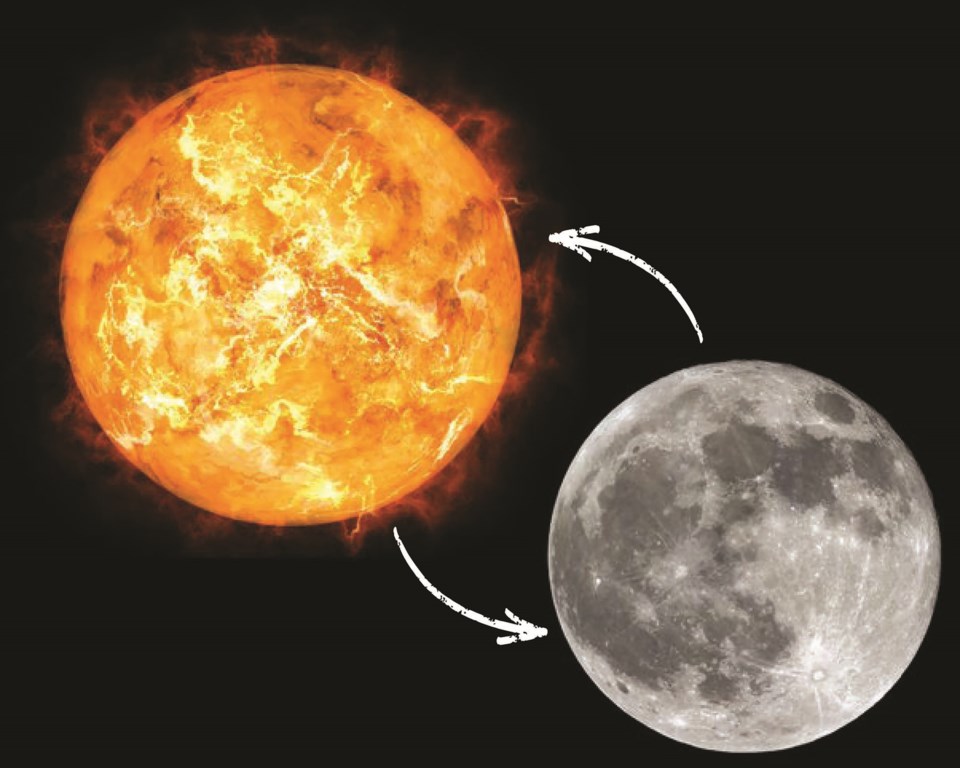Scientific St. Albert
The Gazette is using science to answer questions from students of all ages about the world around them. Send in your questions to [email protected].
Four Winds Public in Morinville was the first to answer the call earlier this year when I asked for questions for Scientific St. Albert. Grade 6 student Zennyn Evans asked a question so awesome I knew I had to save it for the end of the school year: “What if the sun was the moon and the moon was the sun?”
It turns out we could actually swap Earth’s sun with its moon and not completely wreck our planet in the process — but only if we ruin a whole bunch of songs and poems.
Position swap
Simply swapping the positions of the sun and moon would really ruin our day, explained retired University of Alberta astronomy professor Doug Hube.
“The sun is a very, very large body,” he noted — it has a radius of about 700,000 km, which is much bigger than the 385,000 km distance between the Earth and its moon.
Swap the two, and the Earth would end up inside the sun, where the temperature would likely be several million degrees Celsius.
“No normal object would survive in that,” Hube said.
University of Montreal exoplanet scientist Chris Mann said the heat would rip the electrons off the Earth’s matter and transmute it into plasma. The position swap would likely disrupt the orbits of the inner planets of the solar system (the outer ones might not notice), but they’d eventually settle into new paths. The moon, now 150 million km from Earth, would take on a new orbit around the sun and would likely be classified as a dwarf planet.
Let’s try that again, but make the Earth indestructible.
Mann and Hube had different thoughts on what would happen to Earth in this case. The sun’s interior is extremely turbulent, so Hube said the Earth might end up tossed about like a ping-pong ball in boiling water. Mann guessed that the Earth would not have the speed needed to maintain a stable orbit and would eventually get sucked in to sit at the centre of the sun’s core. Residents would see a 24/7 fusion light show in the skies and would finally be able to prove Galileo wrong, as the sun would revolve around the Earth.
Mass swap
What about a moon-sized sun and a sun-sized moon?
Dropping the mass and volume of the sun to that of the moon would result in a cloud of swiftly dispersed hot gas, as it would not have the mass to hold together, Mann said. Inflating the moon to the volume of the sun would spread its mass out so much that it would become a nebula, and likely end up as rings around the nearest planet.
We could get a moon-sized sun if we kept its mass constant but shrank its volume by turning it into a white dwarf, Mann said — a state our sun will eventually reach after it expands to become a red giant in a few billion years.
“They are really hot,” Mann said of white dwarfs — typically tens of thousands of degrees C — and crank out a lot of high-energy X-rays.
Earth would be bathed in high-energy radiation in this scenario, which would probably cook everything, Hube said. Earth would also be wrenched into a very small, fast orbit around the sun, which Hube guessed would cause the length of a year to drop to about 18 days.
Squishing the current sun down to moon-size would be catastrophic, Mann said. Stars become white dwarfs because they run out of hydrogen for fusion and expand until their outer layers blow away. Our current sun has lots of hydrogen, so squishing it would cause a lot of fusion to happen all at once.
“You’d have this enormous explosion of pretty much the whole sun,” Mann said, which could be an issue if Earth was sitting next to it.
Hube said a sun-sized moon (in terms of mass and volume) would be heavy enough to undergo fusion, transforming over millions of years into a star. If we combined this with our moon-sized sun, we would have a binary star system. The stars would orbit each other around a common centre of mass, with the outer planets spinning around them in turn. The inner planets would fall into new orbits around their closest star. If they were equidistant between them, they might get hurled out of the solar system.
Name swap
We could also make the sun the moon and the moon the sun with paperwork.
The International Astronomical Union regulates the official names of all celestial bodies, Hube noted. Theoretically, you could convince said group to swap the names of the moon and the sun without any destructive consequences.
You’d mangle a lot of metaphors, though, which could upset many poets and musicians.



